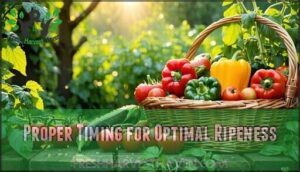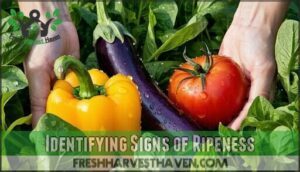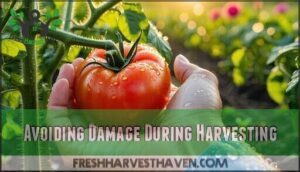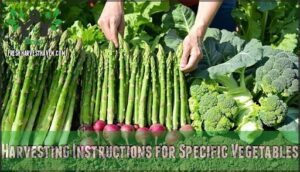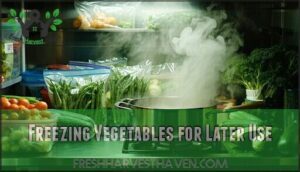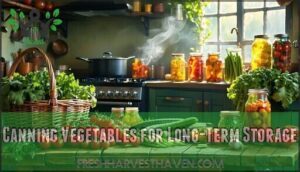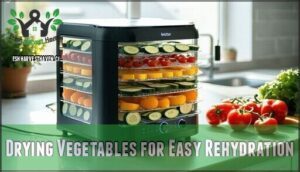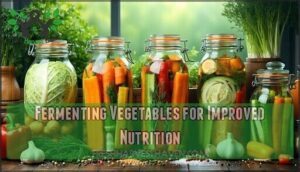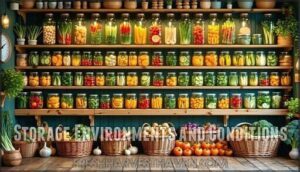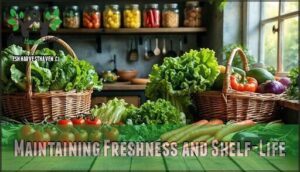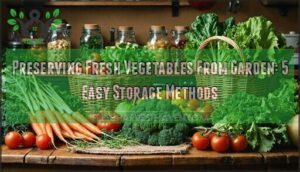This site is supported by our readers. We may earn a commission, at no cost to you, if you purchase through links.
 When learning how to harvest and preserve garden vegetables, timing is key. Pick veggies at their peak—firm tomatoes, crisp cucumbers, or carrots that snap.
When learning how to harvest and preserve garden vegetables, timing is key. Pick veggies at their peak—firm tomatoes, crisp cucumbers, or carrots that snap.
Use clean tools and handle gently to avoid bruising. For preserving, refrigeration works short-term, but freezing locks in flavor for months.
Canning is perfect for soups or sauces, while pickling adds a tangy twist to cucumbers or beets. If you’re low on space, drying and fermenting are fantastic options.
Proper storage—cool, dry, or even in a root cellar—keeps vegetables fresh longer. Each veggie has its quirks, so a bit of know-how goes a long way.
Table Of Contents
- Key Takeaways
- Harvesting Garden Vegetables
- Preserving Garden Vegetables
- Storage Environments and Conditions
- Vegetable-Specific Storage Guidelines
- Maintaining Freshness and Shelf-Life
- Frequently Asked Questions (FAQs)
- How do you preserve a garden harvest?
- How do you preserve vegetables?
- How to keep garden vegetables?
- How to preserve vegetables for winter?
- How do you harvest vegetables?
- Should you can your garden vegetables?
- What is the best way to preserve garden vegetables?
- What is the best method for preserving vegetables?
- How to make garden vegetables last all year?
- How do you preserve crops after harvesting?
- Conclusion
Key Takeaways
- Check vegetables daily and pick them at peak ripeness for best flavor, using clean tools to avoid bruising.
- Preserve your harvest by freezing, canning, drying, or pickling, based on the vegetable and your storage needs.
- Store vegetables properly by matching temperature and humidity requirements, using solutions like root cellars, refrigerators, or breathable containers to maintain fresh longer.
- Regularly inspect and rotate stored produce to prevent spoilage and keep it fresh longer.
Harvesting Garden Vegetables
You’ll get the best flavor and nutrition from your garden vegetables when you harvest them at peak ripeness and handle them properly.
Harvest at peak ripeness to unlock vibrant flavors and nutrition, ensuring a garden-to-table experience that’s truly unforgettable!
Timing your harvest correctly and using the right techniques prevents damage while encouraging your plants to keep producing throughout the growing season, which is crucial for a successful and continuous harvest.
Proper Timing for Optimal Ripeness
In the context of harvesting vegetables, timing separates amateur gardeners from seasoned pros.
Peak ripeness occurs during specific windows that vary dramatically between varieties. Environmental factors like temperature and rainfall shift these harvest schedules, so you’ll need to adapt accordingly.
Check your garden daily during harvest season, watching for those telltale ripeness indicators that signal ideal flavor.
Successive planting timing means staggered harvests throughout the season. Master this timing, and you’ll capture that perfect peak flavor window every single time, achieving the ultimate goal of perfect peak flavor.
Identifying Signs of Ripeness
Identifying ripeness is an art you can master with these quick harvesting tips:
- Look for visual cues like bold color changes (green to red or yellow).
- Feel the texture indicators—firm but slightly soft.
- Rely on size matters—are they fully grown?
- Notice aroma signals—sweet, ripe smells.
- Try taste testing if unsure—perfect flavor means it’s ready!
Harvesting Methods for Different Vegetables
Getting the hang of harvesting garden vegetables? Timing and technique matter! Harvesting methods vary by crop, and a little know-how guarantees peak flavor.
Here’s a quick guide to keep you on track:
Vegetable Harvest Timing Harvest Method
Tip: Use proper harvesting tools like shears or knives for clean cuts, and check ripeness indicators for the best results. Monitor crops daily for ideal harvest timing!
Avoiding Damage During Harvesting
Handle your vegetables with care to keep them kitchen-ready.
Use clean, sharp harvesting tools to avoid bruising or crushing their surfaces. Harvest when plants are dry to minimize disease risks.
Here’s a quick checklist:
- **Use gentle handling for every harvest.
- **Rely on proper tools like shears, not rough hands.
- **Carry soft baskets to prevent damage.
- **Step carefully around plants.
- **Pick vegetables at their best moment.
Harvesting Instructions for Specific Vegetables
Now that you’re focused on avoiding damage during harvesting, let’s look at specific techniques for picking vegetables at their best.
Timing and technique are everything for a successful vegetable harvest.
- Asparagus Snapping: Snap or cut spears when they’re 6-8 inches tall, keeping tips tightly closed. Use sharp tools to avoid damaging plants.
- Bean Harvesting: Pick beans every 2-3 days while pods are firm but tender. Regular picking encourages production.
- Beet Size Management: Pull beets when they’re 1-3 inches in diameter. This size offers the ideal balance of flavor and tenderness.
- Broccoli Cutting: Harvest heads when firm, compact, and full-sized. Use a knife to cut the main stalk, leaving side shoots for later.
- Sprout Maturity: Harvest Brussels sprouts from the bottom up as they mature. Aim for firm, bright green sprouts.
Master these harvesting techniques, and you’ll enjoy healthier, tastier produce!
Preserving Garden Vegetables
Preserving garden vegetables helps you enjoy your harvest long after the growing season ends.
By using methods like freezing, canning, and drying, you can keep your produce fresh and ready for meals year-round.
Freezing Vegetables for Later Use
Freezing vegetables is a simple way to preserve garden freshness.
Start with blanching techniques to lock in nutrition, flavor, and vibrant color.
Proper container selection, like freezer bags or airtight containers, protects against freezer burn.
Label everything with dates for easy tracking.
Organize your freezer to maximize space and efficiency.
When ready to use, employ safe thawing methods to retain texture and taste.
For ideal storage, consider using specialized freezer options.
Freezing also preserves vegetables but also safeguards their nutritional impact.
Canning Vegetables for Long-Term Storage
Canning vegetables is a timeless method for preserving garden harvests. Start with the freshest young vegetables, washing them well and trimming imperfections.
Safe food preservation depends on precise techniques—sterilizing canning jars, maintaining proper acidity levels, and using either water bath or pressure canning methods.
Here’s how to avoid spoilage and guarantee success:
- Monitor processing times and temperatures carefully.
- Use tested recipes for safety.
- Check jar seals regularly for airtightness.
- Label jars with dates to track freshness.
Follow these canning safety steps, and enjoy preserved vegetables year-round! To can successfully, it helps to have the right canning supplies.
Drying Vegetables for Easy Rehydration
Drying vegetables is a simple way to preserve their flavor and nutrients for long-term use.
An electric food dryer is perfect for this, letting you control temperature and drying time for consistent results.
Slice veggies thinly for uniform drying.
Try oven drying at low heat or even sunlight drying for a rustic approach.
Once dried, veggies take up minimal space and have an impressive storage duration.
Consider using an electric food preserver for superior results.
Rehydration techniques are easy—just soak or simmer them to bring back their original texture and taste.
This method allows for long-term use and helps maintain the original texture.
Pickling Vegetables for Added Flavor
Pickling vegetables turns fresh harvests into tangy, flavorful treats.
Start with firm vegetables and use a mix of brine recipes, vinegar, and pickling spices like dill or mustard seeds.
Arrange your veggies in jars with herbs, then pour the brine to cover completely.
It’s quick, easy, and versatile.
Explore fermentation pickling for unique tastes, and always follow pickling safety guidelines.
Fermenting Vegetables for Improved Nutrition
Fermenting vegetables turns your garden’s bounty into probiotic powerhouses packed with gut health benefits.
Start with fresh produce and a simple salt brine to spark fermentation.
Follow these steps:
- Sterilize jars for safety.
- Pack vegetables tightly with seasonings.
- Cover completely with brine.
- Weigh veggies down to stay submerged.
- Let nature work, creating tangy, nutritious veggies.
Storage Environments and Conditions
Storing vegetables properly helps maintain their freshness and flavor for weeks or even months.
You’ll need to match the right conditions—like temperature, humidity, and storage location—to each type of vegetable for the best results, which involves understanding the specific needs of each vegetable to store them properly.
Cool and Dry Storage for Most Vegetables
For successful vegetable storage, cool and dry storage conditions are key. Aim for an ideal temperature of 50-60°F and around 60% humidity.
Breathable container types, like crates or mesh bags, allow air circulation, preventing moisture build-up. Darkness is important—avoid placing vegetables in bright areas to reduce spoilage.
A ventilated root cellar or basement works well for preserving vegetables, keeping them fresh longer without refrigeration while maintaining proper humidity control.
Cold and Dry Storage for Root Crops
Storing your root crops like potatoes or carrots properly keeps your hard work intact. Cold and dry storage is your best friend, with an ideal temperature between 32-40°F.
Here’s how to make it work:
- Control humidity to prevent sprouting or shriveling.
- Use breathable containers for air circulation.
- Inspect regularly for spoilage.
- Rotate vegetables to maintain freshness.
Follow these tips for better vegetable storage and longer-lasting root crops!
Cold and Moist Storage for Certain Vegetables
After managing your root crop storage, focus on veggies needing cold and moist conditions. Your fridge can maintain the perfect environment by setting the crisper to 32–40°F with high humidity.
- Store humidity-sensitive produce like broccoli, lettuce, and kale.
- Use perforated bags to balance moisture and prevent condensation.
- Keep ethylene-producing items (like apples) separate to avoid spoilage.
Optimal containers and air circulation help preserve vegetables, extending freshness and making vegetable storage simpler, which is crucial for maintaining the perfect environment.
Using Basements and Root Cellars for Storage
A root cellar isn’t just old-fashioned—it’s genius for vegetable storage.
Use your basement to keep root crops fresh by focusing on Root Cellar Design and Basement Ventilation. Choose a cool, dark corner (like the northeast wall) for natural insulation.
Add wooden shelving to elevate produce and improve airflow. Humidity Control matters; place pans of water nearby to maintain moisture and prevent shriveling.
For proper Temperature Regulation, aim for 32-40°F for root crops. Don’t skimp on Insulation Methods—thick walls or blankets help maintain steady conditions.
With these tips, you’ll master the art of storing produce for months!
Home Refrigerators for Short-Term Storage
Your refrigerator can be the MVP of short-term vegetable storage if you handle it smartly.
Keep the temperature between 32-40°F for ideal freshness, and use the crisper drawers to separate different types of produce. Humidity control is key—adjust settings or use perforated containers to regulate moisture levels.
Don’t forget, some produce like apples and bananas release ethylene gas, which can spoil sensitive veggies like leafy greens.
- Organize by type: Group similar veggies together for quick access.
- Use breathable bags: Store greens in perforated bags for airflow.
- Avoid overcrowding: Allow space for better air circulation.
- Check regularly: Remove any spoiled produce to prevent spreading.
Vegetable-Specific Storage Guidelines
Storing vegetables properly helps preserve their flavor, texture, and nutrition for longer. Follow specific guidelines for each type to prevent spoilage and guarantee the best quality.
Storage Instructions for Cucumbers and Tomatoes
Cucumbers and tomatoes are storage-sensitive, needing special care.
Humidity levels make a big difference—cucumbers enjoy 85-95% at 45-50°F, while tomatoes prefer 85-90% at 55-70°F for perfect ripening stages.
Don’t refrigerate tomatoes too early; they lose flavor.
Keep them out of direct light and separate from ethylene gas-producing fruits.
Regular visual inspection guarantees quality.
Use proper refrigerator storage only when necessary, maintaining the right storage conditions for extended storage duration.
Storage Instructions for Potatoes and Pumpkins
Storing potatoes and pumpkins correctly can make all the difference for long-lasting freshness.
Here’s your quick guide to their ideal storage:
- Keep potatoes in dark, cool, and moist conditions (around 45-50°F) with good air circulation.
- Store pumpkins above 45°F in a dry, well-ventilated spot, avoiding cold drafts.
Use root cellars or basements for reliable temperature and humidity control.
Never refrigerate these – it ruins their texture.
Regularly check for rot or sprouting to prevent spoilage, ensuring longer shelf life.
Storage Instructions for Root Crops Like Beets and Carrots
If you’re storing root crops like beets and carrots, the key lies in moisture, temperature control, and avoiding rot.
These veggies prefer cool and damp environments. Keep them at 32-40°F with 95% humidity for the best results.
Use sand storage or a root cellar to maintain ideal conditions. Wintering in-ground with a mulch cover is another excellent option, especially in colder climates.
A ventilated container also works well, as long as it’s dark and damp enough to prevent drying out.
Storage Instructions for Delicate Produce Like Basil
Basil’s needs are simple yet precise.
For ideal shelf-life extension, treat it like a fragrant bouquet—place stems in a water-filled glass at room temperature.
Avoid cold drafts, direct sunlight, or extreme humidity.
Change the water every 2-3 days to keep leaves vibrant.
Preserving herbs like basil doesn’t require fancy techniques; just follow these straightforward storage methods, and your garden harvest will retain its incredible aroma and flavor.
Preventing Insect Infestation and Disease
Preventing pests and diseases starts before planting. Focus on crop rotation, companion planting, and maintaining soil health to stop infestations. Inspect seedlings for pests or disease before planting.
Use netting barriers for physical protection, and monitor at least twice a week to catch issues early.
Here’s how you can act now:
- Remove and discard infested plants immediately.
- Use organic pesticides as a last resort.
- Time planting strategically to avoid peak pest seasons.
These steps keep your garden thriving!
Maintaining Freshness and Shelf-Life
Keeping vegetables fresh longer starts with proper handling and storage in the right conditions.
By managing temperature, humidity, and how you organize your produce, you can extend shelf-life and reduce waste.
Expected Shelf-Life for Different Vegetables
After harvesting, understanding how long each vegetable lasts is key to making the most of your garden harvest.
Potatoes and onions are your storage champions, lasting months under cool, dark, ideal conditions.
Leafy greens, however, spoil quickly, lasting just a few days.
Root veggies like carrots and beets fare better, staying fresh for weeks when refrigerated.
Paying attention to storage impact, ripening stages, and variety differences helps you plan better.
Recognizing spoilage signs helps you enjoy your veggies at their peak.
Factors Affecting Shelf-Life Like Temperature and Humidity
Temperature and humidity are the silent guardians of vegetable shelf life.
Missteps can lead to spoilage.
A 10°F temperature shift can shorten storage duration drastically.
To guarantee the best preservation, focus on these:
- Manage storage conditions between 32–60°F based on vegetable type.
- Use humidity control to prevent drying or mold.
- Watch for spoilage indicators like wilting or discoloration.
Handling and Storing Vegetables for Optimal Freshness
Keep vegetables fresh longer by using breathable storage containers for proper air circulation.
Handle produce gently to avoid bruising, which speeds up spoilage.
Maintain storage conditions with consistent temperature control and humidity levels.
Sort items by ripening stages—store leafy greens separately from hardy root crops.
Remove damaged spots immediately to prevent contamination and extend vegetable shelf-life naturally, ensuring the use of proper storage techniques for optimal air circulation.
Rotating Produce for Even Ripening and Use
Rotating your veggies is like choreographing a dance—it keeps your garden in harmony. By rotating produce, you’ll guarantee steady ripening and better garden productivity.
Focus on successive planting and tracking ripening stages to optimize each harvest. Here’s how:
- Monitor ripening stages for each vegetable.
- Harvest at peak freshness to avoid waste.
- Replant immediately after harvest.
- Diversify with variety selection for balance.
- Plan harvests to maintain output, ensuring a steady and productive garden.
Monitoring and Maintaining Storage Conditions for Long-Term Freshness
Keep your vegetables fresh by focusing on greater control in storage.
Use this checklist to maximize your vegetable shelf-life:
- Temperature Monitoring: Keep storage in ideal temperature zones for each vegetable.
- Humidity Control: Prevent spoilage with consistent moisture levels.
- Air Circulation: Allow airflow to avoid mold.
- Spoilage Detection: Inspect regularly for pests and rot.
Regular checks guarantee long-term freshness.
Frequently Asked Questions (FAQs)
How do you preserve a garden harvest?
Think of your garden harvest as treasure—preserve it by freezing veggies after blanching, canning them with care, or drying slices for soups.
Pickling adds zing, while root veggies thrive in cool, moist storage.
How do you preserve vegetables?
Blanch and freeze vegetables for quick meals, can low-acid ones in a pressure canner, or dehydrate for soups.
Pickling adds flavor, while root vegetables store well in cool, moist sand for lasting freshness.
How to keep garden vegetables?
Picture your garden harvest as treasure—store root vegetables in cool, moist sand, leafy greens in the fridge, and onions in a dry, dark spot.
Use breathable containers, rotate often, and inspect regularly.
How to preserve vegetables for winter?
Freeze vegetables after blanching to keep them fresh.
Try canning with care for long-term storage, or dry veggies like peppers for soups.
Pickling’s great too—just add brine. Mix methods for variety all winter!
How do you harvest vegetables?
Picture the morning dew glistening as you gently pick ripe tomatoes with a slight twist, snip peppers with shears, or pull carrots smoothly.
Handle produce carefully to avoid bruising, harvesting when they’re firm and at peak ripeness.
Should you can your garden vegetables?
Canning your garden vegetables is a great option, especially for long-term use.
It keeps flavors intact and prevents waste.
Just follow safety guidelines closely to avoid bacteria, and enjoy your harvest year-round!
What is the best way to preserve garden vegetables?
It’s funny how preserving fresh garden vegetables saves both flavor and effort.
Freeze your blanched veggies, pickle firm favorites, or dehydrate slices for soups.
Pick the method fitting your time, taste, and tools.
What is the best method for preserving vegetables?
The best method depends on the vegetable, but freezing is the easiest overall.
Blanch first to lock in flavor and nutrition, then pack in freezer bags.
For variety, try pickling, canning, or dehydrating.
How to make garden vegetables last all year?
Don’t let your hard work go down the drain—preserve garden vegetables by freezing, canning, drying, or pickling them.
Store root crops cool and moist, and rotate produce regularly to keep it fresh longer.
How do you preserve crops after harvesting?
Start by freezing, drying, pickling, or canning vegetables to keep them fresh.
Blanch before freezing, use a pressure canner for low-acid produce, or dehydrate for soups.
Proper storage guarantees flavor and long-lasting nutrition.
Conclusion
What’s the secret to truly enjoying your garden’s bounty year-round?
Mastering how to harvest and preserve garden vegetables is key. By picking at the right time and using methods like freezing, canning, or pickling, you’ll keep flavors fresh and vibrant.
Proper storage—whether in a root cellar or fridge—extends their life, while techniques like drying or fermenting add flexibility.
With a little care and attention, you’ll turn today’s harvest into tomorrow’s delicious meals with ease and confidence.
- https://gardenchick.myflodesk.com/howtoharvestandstoreguide
- https://www.thespruce.com/why-do-plants-bolt-2539753
- https://www.umassmed.edu/nutrition/blog/blog-posts/2022/7/make-your-own-fermented-vegetables/
- https://www.health.harvard.edu/staying-healthy/fermented-foods-can-add-depth-to-your-diet
- https://www.nature.com/articles/s41598-022-17782-z

